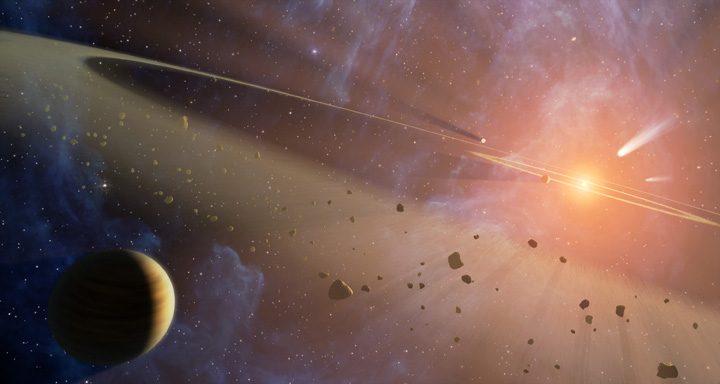

This artist's conception shows the closest known planetary system to our own, called Epsilon Eridani. Credit: NASA/JPL/Caltech
[/caption]
Many stars have been discovered to have narrow discs of warm dust surrounding them. Since dynamical effects with the star’s solar winds should clear these out over long timescales, it’s presumed that these must be recently formed, likely through collisions of small rocky bodies in an asteroid or Kuiper belt. Such a disc has been detected around the nearby star ε Eridani. However, ε Eridani is also known to harbor one planet at a distance of 3.4 AU, and a second one at 40 AU is suspected. Because of this inner planet, any asteroid belt that close would be dynamically unstable as well and should have been cleared out long ago rendering the system incapable of producing dust in this region. So where did ε Eridani get this dust? A new study investigates this.
The inner dust ring was first discovered by a team of astronomers working with the Spitzer Space Telescope last year. In addition to this mysterious inner ring, the system also contains an outer, cold ring of dust at distances greater than 65 AU with a more clumpy nature, possibly shepherded by the outer planet.
The authors of the new paper, led by Martin Reidemeister at Friedrich-Schiller University in Germany, propose that the inner dust ring wasn’t originally formed there. Instead, they propose it was created via collisions in the outer Kuiper belt with the outer ring, but migrated inwards due to an effect known as Poynting-Robertson drag. This effect is created when outflows from the star interact with small objects. While the outflows will ultimately be streaming perpendicular to the orbit, the motion of the orbiting particles will make them plow through this, making them appear to have a component of motion towards the particle in the particle’s reference frame. This is the same effect that makes rain seem as if it’s falling towards you as you’re driving and causes it to pile up on your windshield. Since this added component of motion is opposed to the motion of the particle, it robs the particle of angular momentum, causing it to spiral inwards. Given that ε Eridani is known to have strong winds, this effect seems primed to be an explanation.
To test this hypothesis, the team modeled the system, varying the eccentricity of the inner planet between two possible orbits for the inner planet, both with and without the outer planet, and varying compositions for the outer dust ring (more or less silicates vs. ice). The team found that they could reasonably reproduce the observed system if the dust started as a mixture of ices and silicates in which the ices underwent sublimation as they moved inwards, past the snow line. Additionally, the orbit of the inner planet, though strikingly different for the two proposed orbits, did not have a large effect on the overall distribution of dust.
In the near future, ε Eridani is slated to be the subject of further publications probing its dust discs. The author notes that other teams have already conducted observations using the James Clerk Maxwell Telescope as well as others and that, ε Eridani will likely be a prime target for the James Webb Space Telescope upon launch.
Could a new, fifth force of nature provide some answers to our biggest questions about…
In 2015, the United Nations adopted the 2030 Agenda for Sustainable Development—the Sustainable Development Goals…
Astronomers have been battling threats to their clear skies on all fronts lately. One of…
If you were Captain of the first USS Enterprise, where would you go!? Humanity is…
Now is the best time to observe Mars in 2025. Mars from 2014. Credit: Paul…
Scheduled for launch in 2027, the Nancy Grace Roman Telescope is slowly being readied for…